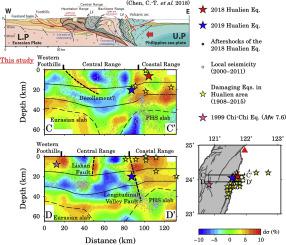Physics of the Earth and Planetary Interiors ( IF 2.4 ) Pub Date : 2021-02-10 , DOI: 10.1016/j.pepi.2021.106673 Genti Toyokuni , Dapeng Zhao , Kate Huihsuan Chen

|
The 2018 Mw 6.4 Hualien earthquake and the 2019 Mw 6.1 Hualien earthquake occurred beneath the eastern coast of Taiwan, at depths of <~20 km. The two earthquakes caused a total of 18 fatalities and widespread damage to infrastructures, especially in the Hualien City. To better understand the generating mechanism of the damaging earthquakes, we conducted seismic tomography to determine high-resolution 3-D models of P and S wave velocity (VP, VS) and Poisson's ratio (σ) in the source zone. We used 334,645 P- and 238,581 S-wave arrival times of 20,825 local earthquakes (1.5 ≤ ML ≤ 6.9) recorded at 47 seismic stations in Taiwan. Our results show that the hypocenters of the two Hualien mainshocks are located at a sharp vertical boundary where seismic velocity and Poisson's ratio change drastically in the horizontal direction, which corresponds to the location of the Longitudinal Valley Fault and its branches. Furthermore, the hypocenters are located right above a high-σ anomaly that is connected to the estimated upper boundary of the subducting Philippine Sea slab, which may reflect ascending fluids dehydrated from the slab. These results suggest that the 2018 and 2019 Hualien earthquakes were triggered by ascending fluids from the slab dehydration, invading into active faults that may be the northern extension of the Longitudinal Valley Fault.











































 京公网安备 11010802027423号
京公网安备 11010802027423号